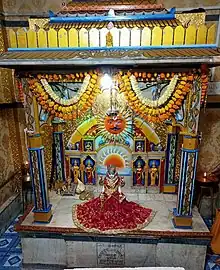| Tapati | |
|---|---|
Goddess of the Tapti River | |
 Shrine of the goddess Tapati, Multai. | |
| Affiliation | Devi |
| Abode | Suryaloka |
| Mantra | Om Sūryaputrī Tāpatya Namaḥ |
| Personal information | |
| Parents | Surya and Chhaya |
| Siblings | Shani, Savarni Manu, Shraddhadeva Manu, Yami, Yama, Ashvins and Revanta |
| Consort | Samvarana |
| Children | Kuru |
| Part of a series on |
| Hinduism |
|---|
 |
| Part of a series on |
| Hindu mythology |
|---|
 |
| Sources |
| Cosmology |
| Deities |
| Personalities of the Epics |
| Hinduism Portal |
Tapati (Sanskrit: तपती, romanized: Tapatī) is a goddess in Hinduism. She is known also as the goddess of the river Tapati (regionally rendered Tapti) and mother-goddess of the south (home of the sun) where she brings heat to the earth. According to Hindu texts, Tapati is the daughter of Surya, the sun god, and Chhaya, one of the wives of Surya.[1]
Etymology
Tapati's name literally means the "warming", "the hot one", "burning one".[2][3] This name is possibly connected to that of the queen of the Scythian gods, Tabiti,[4][5] and it is possible that there was originally a dominant fire goddess in ancient Proto-Indo-Iranian religion.[6]
Legend
Tapati is originally mentioned in the Mahabharata two dozen times, as the wife of Samvarana and the mother of Kuru (the founder of the Kuru dynasty and the Kuru Kingdom). The story of both characters has also been found in other Hindu texts such as the Bhagavata Purana. According to these texts, Tapati's home is situated on the banks of river Tapati.[7][8] The text extols the goddess with the statement that no one in the three worlds could match her in beauty, having perfect features, and severe religious self-discipline.[9]
In the Mahabharata, Arjuna asks a gandharva about the origin of the name Tapatya. The gandharva tells him that the sun once had a beautiful daughter named Tapati, for whom he wished to find a suitable husband. An early Kaurava king named Samvarana worships the sun and is selected as her husband. One day, while out for hunting, the king's horse dies. While wandering, Samvarana sees Tapati bathing in the sunshine and is mesmerised by her beauty. When he asks Tapati about her identity, she immediately disappears. The king falls unconscious, but when he stirs, he sees that Tapati has returned. He declares his love for her, and begs her to be with him. Tapati informs him that she is smitten with him as well, but refers him to her father for his approval for their marriage. The king starts to meditate upon the sage Vasishtha for two weeks, who appears and gathers that the king had fallen in love with a goddess. Vashishta ascends to the sky, asking Surya to approve the marriage of Samvarana and Tapati. Surya agrees to it, and the two promptly get married.[10][11]
According to some Hindu texts,Yami is the elder sister of Tapati, and she has two brothers, Shani and Yama.[12][13]
Worship
Since the goddess Tapati is regarded to be the named after or the personification of the river Tapati, people worship her both in the form of a goddess and as that of an important river having many admirable qualities, enumerated in Hindu texts.[14]
References
- ↑ Hewitt, J. F. History and Chronology of the Myth-Making Age. Рипол Классик. ISBN 9781143716454.
- ↑ Gandhi, Maneka (2004). The Penguin Book of Hindu Names for Girls. Penguin Books India. ISBN 9780143031697.
- ↑ Coulter, Charles Russell; Turner, Patricia (2013-07-04). Encyclopedia of Ancient Deities. Routledge. ISBN 9781135963903.
- ↑ Cheung, Johnny (2007) Etymological Dictionary of the Iranian Verb (Leiden Indo-European Etymological Dictionary Series; 2), Leiden, Boston: Brill, →ISBN, pages 378–379
- ↑ MacLeod, Sharon (Dec 7, 2013). The Divine Feminine in Ancient Europe: Goddesses, Sacred Women and the Origins of Western Culture. McFarland. p. 116-128.- Retrieved 2018-12-17
- ↑ J.Harmatta: "Scythians" in UNESCO Collection of History of Humanity – Volume III: From the Seventh Century BC to the Seventh Century AD. Routledge/UNESCO. 1996. pg 182
- ↑ "Tapati - AncientVoice". ancientvoice.wikidot.com. Retrieved 2017-12-05.
- ↑ "Kuru - AncientVoice". ancientvoice.wikidot.com. Retrieved 2017-12-05.
- ↑ "The Mahabharata, Book 1: Adi Parva: Chaitraratha Parva: Section CLXXIII". www.sacred-texts.com. Retrieved 2017-12-07.
- ↑ Vyasa's Mahabharatam. Academic Publishers. 2008. pp. 99–100. ISBN 978-81-89781-68-2.
- ↑ Buitenen, J. A. B. van; Buitenen, Johannes Adrianus Bernardus (1973). The Mahabharata, Volume 1: Book 1: The Book of the Beginning. University of Chicago Press. ISBN 9780226846637.
- ↑ "Tapati - AncientVoice". ancientvoice.wikidot.com. Retrieved 2017-12-06.
- ↑ Dalal, Roshen (2014-04-18). Hinduism: An Alphabetical Guide. Penguin UK. ISBN 9788184752779.
- ↑ Singh, Mahesh Prasad; Singh, J. K.; Mohanka, Reena (2007). Forest Environment and Biodiversity. Daya Publishing House. ISBN 9788170354215.
